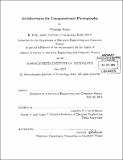Architectures for computational photography
Author(s)
Raina, Priyanka
DownloadFull printable version (12.50Mb)
Other Contributors
Massachusetts Institute of Technology. Department of Electrical Engineering and Computer Science.
Advisor
Anantha P. Chandrakasan.
Terms of use
Metadata
Show full item recordAbstract
Computational photography refers to a wide range of image capture and processing techniques that extend the capabilities of digital photography and allow users to take photographs that could not have been taken by a traditional camera. Since its inception less than a decade ago, the field today encompasses a wide range of techniques including high dynamic range (HDR) imaging, low light enhancement, panorama stitching, image deblurring and light field photography. These techniques have so far been software based, which leads to high energy consumption and typically no support for real-time processing. This work focuses on hardware architectures for two algorithms - (a) bilateral filtering which is commonly used in computational photography applications such as HDR imaging, low light enhancement and glare reduction and (b) image deblurring. In the first part of this work, digital circuits for three components of a multi-application bilateral filtering processor are implemented - the grid interpolation block, the HDR image creation and contrast adjustment blocks, and the shadow correction block. An on-chip implementation of the complete processor, designed with other team members, performs HDR imaging, low light enhancement and glare reduction. The 40 nm CMOS test chip operates from 98 MHz at 0.9 V to 25 MHz at 0.9 V and processes 13 megapixels/s while consuming 17.8 mW at 98 MHz and 0.9 V, achieving significant energy reduction compared to previous CPU/GPU implementations. In the second part of this work, a complete system architecture for blind image deblurring is proposed. Digital circuits for the component modules are implemented using Bluespec SystemVerilog and verified to be bit accurate with a reference software implementation. Techniques to reduce power and area cost are investigated and synthesis results in 40nm CMOS technology are presented
Description
Thesis (S.M.)--Massachusetts Institute of Technology, Dept. of Electrical Engineering and Computer Science, 2013. Cataloged from PDF version of thesis. Includes bibliographical references (p. 93-94).
Date issued
2013Department
Massachusetts Institute of Technology. Department of Electrical Engineering and Computer SciencePublisher
Massachusetts Institute of Technology
Keywords
Electrical Engineering and Computer Science.